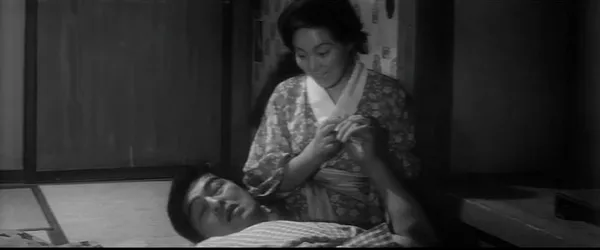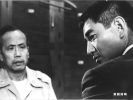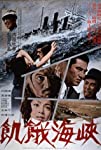Eye For Film >> Movies >> A Fugitive From The Past (1966) Film Review
A Fugitive From The Past
Reviewed by: Jennie Kermode

There are echoes of 1932 classic I Am A Fugitive From A Chain Gang in Uchida Tomo’s 1965 thriller. Despite being younger, it hasn’t survived the ravages of time as well and looks pretty grainy and blurred in places, but it tackles the same theme of a single incident completely restructuring the life of a man who may initially have been innocent. Japanese audiences being less easily shocked by crime itself, the film ends up going to much darker places, but it has a similar approach to positioning the desperate behaviours of its central character (variously known as Takichi Inugai and Kyôichirô Tarumi, and played by Mikuni Rentarô) as a product of circumstance and systemic failure rather than wholly a product of free will – with all the layers of tragedy that implies.
Variously titled in English as A Fugitive From The Past or Fugitives From The Past, this was originally known as Kiga Kaikyô, which means something more along the lines of ‘remarkable achievement’ – a phrase which could apply equally well to Inugai (in regard to his survival or intermittent displays of physical strength) or to the detective (Mitsui Kôji) who stays on his trail for ten long years, even after his retirement. There is also no small level of achievement on the part of its other main character, Yae Sugito (Hidari Sachiko), a sex worker who transforms her life, and she, like Inugai, fits the description offered by the English titles.

Inugai and Yae meet when he’s on the run after a violent crime in Iwanai leaves a family dead. He has fled across the strait during a typhoon, his two companions lost – or murdered – along the way, and initially presumed to be victims of a larger shipwreck (real footage of a ship being tossed about during a typhoon adds to the drama and sense of tragedy here). Hiding out in a brothel, Inugai always calls Yae by her family name, showing unusual respect for her, and initially refuses her sexual advances. She quickly starts calling him by his personal name, hinting at a genuine affection which grows stronger over time. Although they eventually become lovers, he cannot give her the relationship she longs for, so instead he tries to help her by leaving her money. This act of kindness, and her later efforts to show due gratitude, prove more dangerous to both of them than any of their other choices.
The film is interesting in its use of visual effects, with layered images used in transitions and also to communicate dream-like states. There’s an element of the Gothic about it, a suggestion of supernatural influence which further complicates the issue of free will. The room in which Inugai and Yae spend time together looks directly out at the imposing Mount Fear, described as ‘the mountain which makes dead people talk’, and lightning flashes arounds its summit. At key moments in the film, thunder rumbles ominously and rain pours down in torrents, speaking to a loss of control which neither of these characters can afford. We are reminded, in these scenes, of the initial typhoon, of the wreckage in Hokkaido through which the detective trawled. The final scene returns to this imagery: individual human lives are dominated by the elements.
The film is slow in places and its mixture of dour, emotionally distanced stoicism and wild displays of passion is likely to be a stumbling block for many viewers, especially in the West, where this stylistic approach is less common. It takes a long time to make its points, but then, part of what it is addressing is the burden of maintaining a difficult commitment over time. Inugai is a complex character. The detective doesn’t buy his protestations of innocence, but there’s a sense that he admires him for his strength, for his capacity to endure or to exert force, against the odds, in such a world. In better condition and with a tighter edit, this would be a compelling film. As it is, it may not quite get there, but it’s still well worth a watch.
Reviewed on: 24 Sep 2022


















